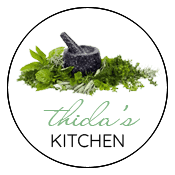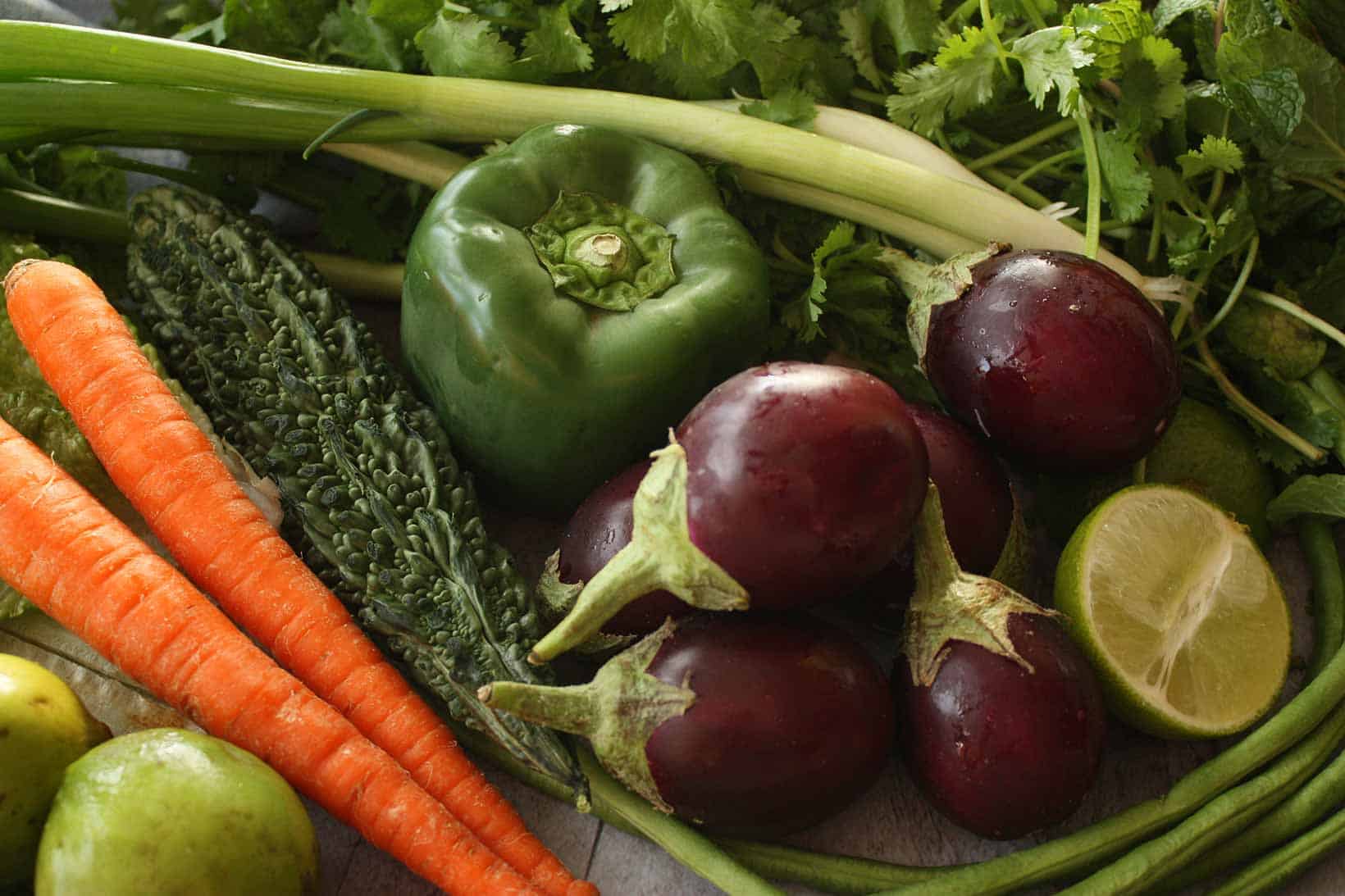Vegetables make up the largest portion of the typical Cambodian diet. Although Cambodian food is centered around meat and seafood, it’s the vegetables that really define the cuisine and give it its unmistakable flavors and textures.
In the article below, we’ve listed some of the most common fresh vegetables you can find at domestic markets in Cambodia. We’ve broken the vegetables down into 3 categories — roots, leafy greens, and gourds.
Cambodian root vegetables
Cambodian root vegetables include staples that are cultivated worldwide, but also numerous plants that are unique to the region. In Cambodia, root vegetables are utilized in a variety of soups, stir-fries, and even desserts. Below are some of the most common root vegetables in Cambodian cooking.
Sweet potatoes
Sweet potatoes are a typical Cambodian snack and dessert. You’ll usually find deep-fried sweet potatoes deep-fried sold at street food stalls throughout the country. That said, Cambodians also use sweet potatoes in curries and soups.
Bamboo shoots
Bamboo shoots are the sprouts of the bamboo plant, which are edible while they’re young. Bamboo shoots have a sweet, nutty, and pleasant taste, while their texture is crunchy — even when cooked. Most species of bamboo must be cooked before you eat them, and in Cambodian cuisine, you’ll usually find bamboo shoots in stir fries and soups.
Daikon radish
Daikon radish has the same typical bite as its smaller radish cousin, but with less intensity. Daikon is popular in cuisines throughout east Asia, from Japan to Thailand. In Cambodia, daikon finds use in a variety of soups (notably in kuy teav, or Phnom Penh noodles) and also gets preserved and served as a side dish.
Taro root
Taro root is grown throughout Southeast Asia, Africa, and Oceania. Taro root’s taste resembles that of a sweet potato, albeit with a milder, nuttier flavor. In Cambodia, taro root gets deep-fried like French fries (but sweet!), is used as a filling in spring rolls, and makes the base for several desserts.
Lotus root
Lotus root is the edible rhizome from which lotus lily stems and flowers grow. Lotus root has a crunchy texture and a mildly sweet taste, which is why it’s a common ingredient in Asian stir fries. In Cambodia, lotus root is mostly used in soups, and occasionally stir fries.
Carrots
Carrots are seldom eaten raw in Cambodia. Most of the time, people either add carrots to soups, where the carrots infuse the broth with natural sweetness. That said, diced carrots are a staple ingredient in fried rice and fried noodle dishes, too. Often, thinly sliced carrots are also preserved alongside daikon radish, with the resulting fermented mix served as a spicy, crunchy side to meat dishes.
Cambodian leafy greens
No Cambodian meal goes without an assortment of leafy greens. While Cambodian cuisine doesn’t have many Western-style salads, leafy greens are served fresh, with dipping sauces, in soups, and in stir fries. Below is a list of the most popular leafy greens used in Cambodian cuisine.
Bok choy
Bok choy is a popular stir fry ingredient in Cambodia, just as it is in most Southeast Asian cuisines. In most recipes, bok choy is stir fried with a bit of oyster sauce, fish sauce, and a protein of choice for a simple, balanced main dish that’s served with a side of rice. That said, you’ll also find bok choy in soups — it works well in any soup where a leafy green vegetable is required, particularly one with a pork bone broth. We’ve also used bok choy to make this fried noodles recipe.
Green onions
Green onions are a staple ingredient in Cambodian cuisine, and they’re used to add flavour to anything from omelets to the famed kuy teav soup. Green onions are widely grown and available throughout Cambodia, much as they are throughout the world.
Morning glory
Morning glory (also known as “water spinach”) is a leafy plant with a long stem and elongated, narrow leaves. Morning glory is quite fleshy and juicy, and these qualities make it a popular stir fry ingredient in Cambodia. In fact, one of the most basic Cambodian vegetarian dishes is a stir fry with morning glory, oyster sauce, and garlic.
Apart from stir fries, morning glory is famously used in samlor machu, a sour soup made with a kreung base, morning glory, and beef.
Bean sprouts
Crunchy and refreshing, bean sprouts are synonymous with Thai stir fries, namely pad thai. However, bean sprouts are equally irreplaceable in Cambodian cooking, too. Bean sprouts are an indispensable ingredient in kuy teav, nom banh chok, and countless stir fries. Most Cambodian recipes favor mung bean sprouts over soy bean sprouts, as the former are more delicate and have smaller heads.
Green cabbage
Green cabbage finds an assortment of uses in Cambodian cooking — it goes in various soups, gets fermented, stir-fried, pickled, and eaten raw. Raw, green cabbage is one of the many raw vegetables Cambodians like to eat with pungent, spicy kapi- or prahok-based dips.
Napa cabbage
Napa cabbage (also known as “Chinese cabbage”) is ubiquitous in East and Southeast Asian cooking. Napa cabbage is a softer, leafier, and elongated version of the regular cabbage. Its leafiness makes it a popular ingredient in Cambodian soups. However, Cambodians also grill napa cabbage to go with barbecued meats and eat it raw with various dips.
Mustard greens
Mustard greens are a pickled favorite across much of East and Southeast Asia. The tough, leafy greens have the bite you’d normally associated with mustard, and make delicious, sour, crunchy pickles. Pickled mustard greens are ingredients in several side and main dishes, including egg stir fries and pork bone soup.
Cambodian gourds
Most gourds used in Cambodian kitchens originate in East and Southeast Asia. These gourds range from sweet and mild to bitter, and are used in many different types of meals. Here are some gourds that are widely used by Cambodian cooks.
Bitter melon
Bitter melon tastes exactly the way it sounds — it’s bitter. And it gets more bitter as it ripens. In Cambodia, bitter melon is most commonly used to prepare a soup in which the gourd gets stuffed with ground pork. However, some people also fry thinly sliced bitter melon with scrambled eggs.
Chinese eggplant
Chinese eggplant is an elongated version of the Globe Eggplant, which is more prevalent in the United States. The longer, narrow shape is the main distinguishing characteristic of the Chinese eggplant, although it’s also lighter in color than its American counterpart. In Cambodia, Chinese eggplant is eaten raw with dips, added to curries, stir-fried, and grilled.
Thai eggplant
Thai eggplant is a smaller, bulbous eggplant with a slightly bitter taste and a crunchy texture. In Thai and Cambodian cuisine, Thai eggplant is either eaten raw with a spicy, pungent dip or added (again, raw) to green papaya salad. In the papaya salad, the eggplant’s mildly bitter and refreshing flesh pairs well with the piquant, sour salad dressing. Although it’s not commonly practiced in Cambodian cooking, Thai eggplant can be stir fried; the cooking process tones down the bitterness.
Pea eggplant
Pea eggplant is a staple ingredient in Thai cuisine (where it often finds itself in curries) and across the border in Cambodia. In Cambodian cooking, pea eggplant is commonly added to soups such as samlor korkor and samlor prohaer, eaten raw with prahok-based dips, and added to prahok ktiss.
Ridge gourd
Ridge gourd (also known as Chinese okra) is grown throughout East, South, and Southeast Asia, and the fruit gets harvested and eaten while green. Ridge gourd tastes mildly sweet, and, similar to any summer squash, it easily absorbs the flavors with which you cook it. In Cambodia, ridge gourd is generally fried with scrambled eggs or stir-fried with shrimp.
Buttercup squash
Buttercup squash is a winter squash with tough skin and firm, sweet flesh. In Cambodian cooking, buttercup squash is commonly used as a dessert ingredient in the buttercup squash custard recipe. However, Cambodians also stir-fry buttercup squash with ground pork and add it to various soups, like samlor korko.

